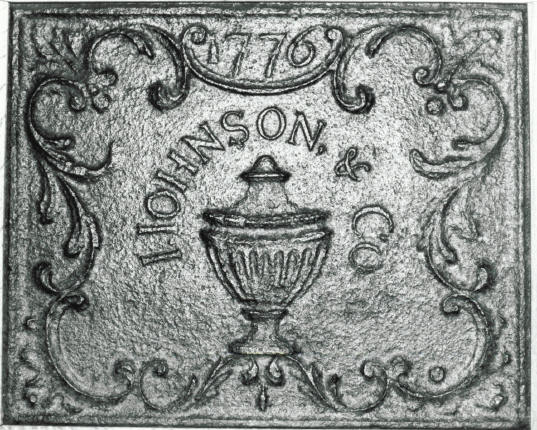(11/17) The Catoctin Furnace Historical Society will showcase an antique fireback donated by Mr. Richard Miller and the late Mrs. Dixie Miller of Frederick, Maryland, at their Traditional Village Christmas celebration on December 6, 2014. The fireback was forged in the village iron furnace at Catoctin Furnace.

The cast iron fireback from the James Johnson and Co. furnace in Catoctin Furnace, Maryland, is dated 1776. It is a rare surviving example of the products made by the furnace during the revolutionary war. The fireback is 19 inches high, 23 inches wide and ¾ inch thick. (The same fireback is pictured on page 15 of the book Catoctin Furnace: Portrait of an Iron-Making
Village by Elizabeth Yourtee Anderson.) In addition to the date, the fireback bears the company name, a classical urn, and a fancy border. It is in excellent condition, according to John C. Newcomer, a noted art and antique appraiser.
In 1976, Mr. Miller found the fireback upside down and being used as a step behind the back door of 108 North Main Street in Woodsboro, Maryland. Mr. Miller acquired the fireback from the building owner and has preserved it in his home for the last 38 years. Researching the owners of the Woodsboro house in order to find out if they had any connection with the furnace in
the late 18th or early 19th century, we found that, in 1794, the house was transferred from Jacob Good to John Campbell. Clearly, the Woodsboro house was standing and occupied during the period when Johnson operated Catoctin Furnace (ca. 1790s-1810). The fireback may have been installed in a fireplace when the house was built in the late 1700s. We are still trying to determine whether any owners
of 108 North Main Street were associated with Catoctin Furnace.
In 1774, the Catoctin Furnace was built by four brothers in order to produce iron from the rich deposits of hematite found in the nearby mountains. The iron furnace at Catoctin played a pivotal role during the early years of the industrial revolution in the young United States. Cannonballs fired during the battle of Yorktown were made at the furnace. The furnace industry
supported a thriving community, and company houses were established alongside the furnace stack. Throughout the nineteenth century, the furnace produced iron for household and industrial products. After more than 100 years of operation, the Catoctin Furnace ceased production in 1903.
The fireback will be on display during "Traditional Village Christmas" on Saturday, December 6, 2014, from 10 a.m. to 4 p.m., in the Collier’s Log House at 12607 Catoctin Furnace Road in the village of Catoctin Furnace, near Thurmont, Maryland. Each year at Traditional Village Christmas, volunteers for the Catoctin Furnace Historical Society decorate wreaths to your
design. Bows, pinecones, ornaments, icicles and many other decorative items are available for you to choose. Sip mulled cider, select delicious baked goods, and shop for unique handmade gifts at the same time!
Read
other news articles on Thurmont